Asthma
Bronchial asthma; Wheezing - asthma - adults
Asthma is a chronic disease that causes the airways of the lungs to swell and narrow. It leads to breathing difficulty such as wheezing, shortness of breath, chest tightness, and coughing.

Breathing is something we do without even thinking about it. But some people have a hard time breathing easily. They wheeze, cough, and just can't get enough air into their lungs. Let's talk about asthma. Normally when you breathe, oxygen-rich air enters your nose and mouth and travels to the airways in your lungs. But when you have an asthma attack, the muscles in your airways tighten. Your airways swell up and get narrower. It's like pressing on a straw when you're trying to drink through it. The more you press, the less of your drink can squeeze up through the straw. In the same way, less air can squeeze through tight airways into your lungs. So, what causes asthma? People with asthma have different triggers. Some people are sensitive to pet hair or dander. Others find that dust, pollen, smoke, or chemicals make them wheeze. You may have trouble breathing when you're under stress or working out at the gym. Often people with asthma have allergies that trigger their attacks. Others have a parent or other relative who has allergies. You may ask, how can you know for sure that you have asthma? During an asthma attack, you'll have trouble breathing. You may cough or wheeze as you try to draw air into your lungs. If you're having a severe attack, your lips and face may turn blue and you'll have a hard time getting any air. That's when it's time to call for emergency help. Your doctor will listen to your lungs with a stethoscope, and may do other tests to check your blood and lung function. To find out what's triggering your asthma, you may need to be tested for allergies to mold, pollen, pet dander, or other substances. To measure the strength of air flowing out of your lungs, you'll blow into a device called a peak flow meter. You can also use a peak flow meter to make sure you're keeping your asthma under control. Different medicines are used to prevent and treat asthma. Control drugs help you avoid asthma attacks, but you need to take them every day for them to work. You breathe in control drugs like Flovent, Singulair, and Pulmicort through an inhaler. If you're having an asthma attack, you can take a quick-relief drug to control your wheezing. Examples of quick-relief drugs include short-acting inhaled drugs and steroid medicines that you take by mouth. When you have asthma, you need to be prepared. Know your asthma triggers and try to avoid them. Carry an inhaler with you in case you have an asthma attack. If you ever have an attack that's so severe you can't breathe, call 911 or get emergency medical help.

The major features of the lungs include the bronchi, the bronchioles and the alveoli. The alveoli are the microscopic blood vessel-lined sacks in which oxygen and carbon dioxide gas are exchanged.

Spirometry is a painless study of air volume and flow rate within the lungs. Spirometry is frequently used to evaluate lung function in people with obstructive or restrictive lung diseases such as asthma or cystic fibrosis.
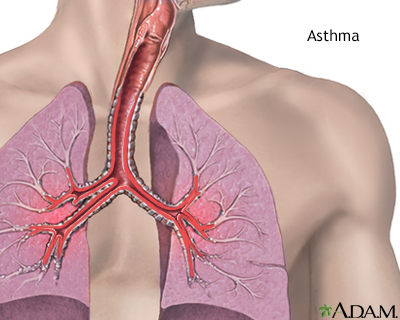
Asthma is a disease in which inflammation of the airways causes airflow into and out of the lungs to be restricted. The muscles of the bronchial tree become tight and the lining of the air passages swells, reducing airflow and producing the characteristic wheezing sound. This is known as an asthma attack, which can occur as an allergic reaction to an allergen or other substance (acute asthma), or as a part of a complex disease cycle which may include reaction to stress or exercise (chronic asthma).
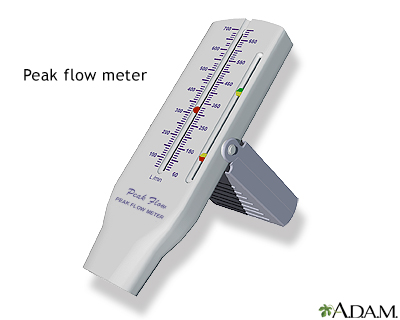
A peak flow meter is commonly used by a person with asthma to measue the amount of air that can be expelled from the lungs. If the airways become narrow or blocked due to asthma, peak flow values will drop because the person cannot blow air out of the lungs as well. A peak flow meter can be a useful aid in monitoring a person's asthma over time and can also be used to help determine how well a patient's medications are working.
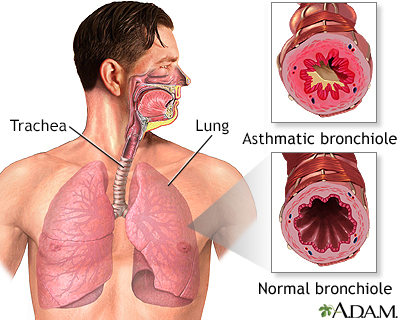
Asthma is a disease in which inflammation of the airways causes airflow into and out of the lungs to be restricted. When an asthma attack occurs, mucus production is increased, muscles of the bronchial tree become tight, and the lining of the air passages swells, reducing airflow and producing the characteristic wheezing sound.
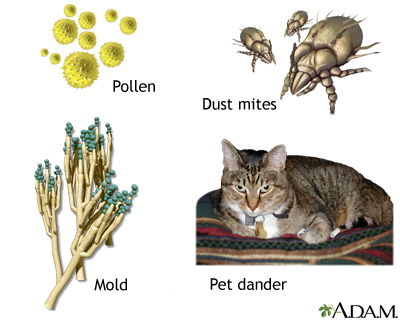
Many of the same substances that trigger allergies can also trigger asthma. Common allergens include pollen, dust mites, mold and pet dander. Other asthma triggers include irritants like smoke, pollution, fumes, cleaning chemicals, and sprays. Asthma symptoms can be substantially reduced by avoiding exposure to known allergens and respiratory irritants.

Wheezing can be a normal healthy response to an unhealthy environment. Or, wheezing can be a sign of asthma. I'm Dr. Alan Greene and I want to talk with you for a moment about how to tell the difference, what causes wheezing anyway, and when is it healthy and when is it not. Well to understand that, first let's all take a deep breath together (inhales). When you breathe in, the air comes through your nose or mouth, through the big windpipe and breaks into 2 big bronchi, one into each lung. And from there they break into a whole bunch of little, smaller bronchioles. It's almost like a tree's branches branching out. And those bronchioles are where the wheezing happens. Let's look at a bronchiole. Here's one of those small airways. Now if you happen to walk into a cloud of something that's toxic, your body is going to respond instantly to try to protect you. The first thing that will happen is the muscles around the bronchioles will tighten, will constrict down almost like a boa constrictor, and you get the tight airways. If that toxic cloud is still there, to protect your delicate tissues deep in your lungs, swelling of the lining will happen. Inflammatory stuff to help protect you from those toxins. And if it's still there, still irritating, mucus will begin to be secreted to be able again to capture and protect you from those toxins. That's wheezing. Asthma happens when your airways are hyper-responsive. When they're twitchy. When they're hyper-alert and they respond to something that's not truly dangerous. The problem with that is when your bronchioles are constricted and swollen and has mucus in them, that narrow little opening is hard to breathe through. You have to work to breathe, especially to breath out. And that hard breathing through a narrow passageway is what creates the sound we know as wheezing.
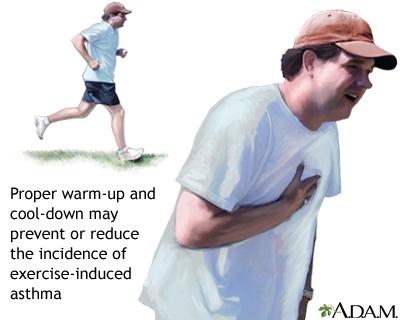
Exercise-induced asthma is distinct from allergic asthma in that it does not produce long-term increase in airway activity. People who only experience asthma when they exercise may be able to control their symptoms with preventive measures such as warm-up and cool-down exercises.

Air is breathed in through the nasal passageways, travels through the trachea and bronchi to the lungs.
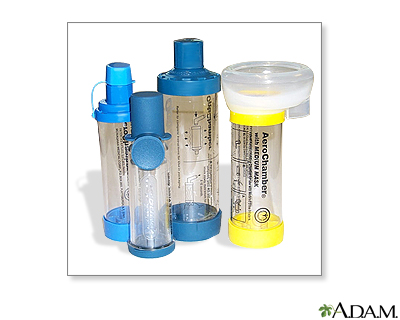
Spacers (also called holding chambers) work with your metered dose inhaler (MDI) to deliver inhaled medication more easily and effectively, and can reduce side effects. Spacers hold the puff of medicine between you and the MDI, so that you can inhale it slowly and more completely. As a result, more of the medicine gets into your airways.
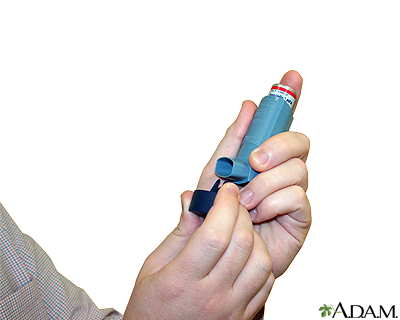
Remove the cap from the end of the inhaler. Check for any dust, lint, or other objects. Shake the inhaler well.
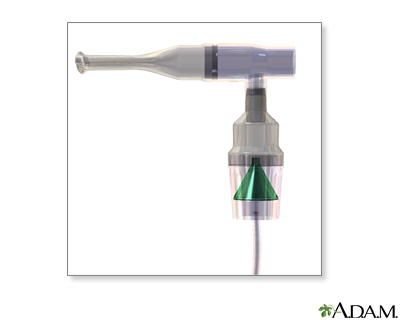
Nebulizers are used to treat asthma, Chronic Obstructive Pulmonary Disease (COPD), and other conditions where inhaled medicines are indicated. Nebulizers deliver a stream of medicated air to the lungs over a period of time.
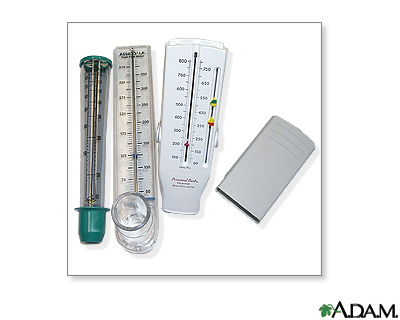
A peak flow meter helps you check how well your asthma is controlled. Use it every day, and keep track of the results to help your doctor learn about your asthma. This may also help you determine if your asthma is getting worse, even before you have symptoms.
Breathing is something we do without even thinking about it. But some people have a hard time breathing easily. They wheeze, cough, and just can't get enough air into their lungs. Let's talk about asthma. Normally when you breathe, oxygen-rich air enters your nose and mouth and travels to the airways in your lungs. But when you have an asthma attack, the muscles in your airways tighten. Your airways swell up and get narrower. It's like pressing on a straw when you're trying to drink through it. The more you press, the less of your drink can squeeze up through the straw. In the same way, less air can squeeze through tight airways into your lungs. So, what causes asthma? People with asthma have different triggers. Some people are sensitive to pet hair or dander. Others find that dust, pollen, smoke, or chemicals make them wheeze. You may have trouble breathing when you're under stress or working out at the gym. Often people with asthma have allergies that trigger their attacks. Others have a parent or other relative who has allergies. You may ask, how can you know for sure that you have asthma? During an asthma attack, you'll have trouble breathing. You may cough or wheeze as you try to draw air into your lungs. If you're having a severe attack, your lips and face may turn blue and you'll have a hard time getting any air. That's when it's time to call for emergency help. Your doctor will listen to your lungs with a stethoscope, and may do other tests to check your blood and lung function. To find out what's triggering your asthma, you may need to be tested for allergies to mold, pollen, pet dander, or other substances. To measure the strength of air flowing out of your lungs, you'll blow into a device called a peak flow meter. You can also use a peak flow meter to make sure you're keeping your asthma under control. Different medicines are used to prevent and treat asthma. Control drugs help you avoid asthma attacks, but you need to take them every day for them to work. You breathe in control drugs like Flovent, Singulair, and Pulmicort through an inhaler. If you’re having an asthma attack, you can take a quick-relief drug to control your wheezing. Examples of quick-relief drugs include short-acting inhaled drugs like Albuterol. When you have asthma, you need to be prepared. Know your asthma triggers and try to avoid them. Carry an inhaler with you in case you have an asthma attack. If you ever have an attack that's so severe you can't breathe, call 911 or get emergency medical help.
Causes
Asthma is caused by swelling (inflammation) in the airways. An asthma attack occurs when the lining of the air passages has become swollen and the muscles surrounding the airways become tight. This narrowing reduces the amount of air that can pass through the airway.
Asthma symptoms can be caused by breathing in substances called allergens or triggers, or by other causes.
Common asthma triggers include:
- Animals (pet hair or dander)
- Dust mites
- Certain medicines (aspirin and other NSAIDs)
- Changes in weather (most often cold weather)
- Chemicals in the air (pollution) or in food
- Physical activity
- Mold
- Pollen
- Respiratory infections, such as the common cold and many other viruses
- Strong emotions (stress)
- Tobacco or other inhalant that is smoked
Substances in some workplaces can also trigger asthma symptoms, leading to occupational asthma. The most common triggers are wood dust, grain dust, animal dander, fungi, or chemicals.
Many people with asthma have a personal or family history of allergies, such as hay fever (allergic rhinitis) or eczema. Others have no history of allergies.
Symptoms
Asthma symptoms vary from person to person. For example, you may have symptoms all the time or mostly during physical activity.
Most people with asthma have attacks separated by symptom-free periods. Some people have long-term shortness of breath with episodes of increased shortness of breath. Wheezing or a cough may be the main symptom.
Asthma attacks can last for minutes to days. An asthma attack may start suddenly or develop slowly over several hours or days. It may become dangerous if airflow is severely blocked.
Symptoms of asthma include:
- Cough with or without sputum (phlegm) production
- Pulling in of the skin between the ribs when breathing (intercostal retractions)
- Shortness of breath that gets worse with exercise or activity
- Whistling sound or wheezing as you breathe
- Pain or tightness in the chest
- Difficulty sleeping
- Abnormal breathing pattern (breathing out takes more than twice as long as breathing in)
Emergency symptoms that need prompt medical help include:
- Bluish color to the lips and face (cyanosis)
- Decreased level of alertness, such as severe drowsiness or confusion, during an asthma attack
- Extreme difficulty breathing
- Rapid pulse
- Severe anxiety due to shortness of breath
- Sweating
- Difficulty speaking
- Breathing temporarily stops
Wheezing can be a normal healthy response to an unhealthy environment. Or, wheezing can be a sign of asthma. I'm Dr. Alan Greene and I want to talk with you for a moment about how to tell the difference, what causes wheezing anyway, and when is it healthy and when is it not. Well to understand that, first let's all take a deep breath together (inhales). When you breathe in, the air comes through your nose or mouth, through the big windpipe and breaks into 2 big bronchi, one into each lung. And from there they break into a whole bunch of little, smaller bronchioles. It's almost like a tree's branches branching out. And those bronchioles are where the wheezing happens. Let's look at a bronchiole. Here's one of those small airways. Now if you happen to walk into a cloud of something that's toxic, your body is going to respond instantly to try to protect you. The first thing that will happen is the muscles around the bronchioles will tighten, will constrict down almost like a boa constrictor, and you get the tight airways. If that toxic cloud is still there, to protect your delicate tissues deep in your lungs, swelling of the lining will happen. Inflammatory stuff to help protect you from those toxins. And if it's still there, still irritating, mucus will begin to be secreted to be able again to capture and protect you from those toxins. That's wheezing. Asthma happens when your airways are hyper-responsive. When they're twitchy. When they're hyper-alert and they respond to something that's not truly dangerous. The problem with that is when your bronchioles are constricted and swollen and has mucus in them, that narrow little opening is hard to breathe through. You have to work to breathe, especially to breath out. And that hard breathing through a narrow passageway is what creates the sound we know as wheezing.
Exams and Tests
The health care provider will use a stethoscope to listen to your lungs. Wheezing or other asthma-related sounds may be heard. The provider will take your medical history and ask about your symptoms.
Tests that may be ordered include:
- Allergy testing -- a skin test or a blood test to see if a person with asthma is allergic to certain substances
- Arterial blood gas -- often done in people who are having a severe asthma attack
- Chest x-ray or CT scan of the chest -- to check other conditions
- Lung function tests, including peak flow measurements
Treatment
The goals of treatment are to:
- Control airway swelling
- Limit exposure to substances that may trigger your symptoms
- Help you to be able to do normal activities without having asthma symptoms
You and your provider should work as a team to manage your asthma symptoms. Follow your provider's instructions on taking medicines, eliminating asthma triggers, and monitoring symptoms.
MEDICINES FOR ASTHMA
There are two kinds of medicines for treating asthma:
- Control medicines to help prevent attacks
- Quick-relief (rescue) medicines for use during attacks
These are also called maintenance or control medicines. They are used to prevent symptoms in people with moderate to severe asthma. You must take these medicines every day for them to work. Take them even when you feel OK.
Some long-term medicines are breathed in (inhaled), such as steroids and long-acting beta-agonists. Others are taken by mouth (orally). Your provider will prescribe the right medicine for you.
These are also called rescue medicines. They are taken:
- For coughing, wheezing, trouble breathing, or during an asthma attack
- Just before physical activity to help prevent asthma symptoms
Tell your provider if you are using quick-relief medicines twice a week or more. If so, your asthma may not be under control. Your provider may change the dose or your daily asthma control medicine to reduce the use of quick-relief medicines.
Quick-relief medicines include:
- Short-acting inhaled bronchodilators
- Oral corticosteroids for a severe asthma attack
A severe asthma attack requires a checkup by a provider. You may also need a hospital stay. There, you will likely be given oxygen, breathing assistance, and medicines given through a vein (IV).
ASTHMA CARE AT HOME
You can take steps to decrease the possibility of asthma attacks:
- Know the asthma symptoms to watch for.
- Know how to take your peak flow reading and what it means.
- Know which triggers make your asthma worse and what to do when it happens.
- Know how to care for your asthma before and during physical activity or exercise.
Asthma action plans are written documents for managing asthma. An asthma action plan should include:
- Instructions for taking asthma medicines when your condition is stable
- A list of asthma triggers and how to avoid them
- How to recognize when your asthma is getting worse, what to do and when to call your provider
A peak flow meter is a simple device to measure how quickly you can move air out of your lungs.
- It can help you see if an attack is coming, sometimes even before symptoms appear. Peak flow measurements help let you know when you need to take medicine or other action.
- Peak flow values of 50% to 80% of your best results are a sign of a moderate asthma attack. Numbers below 50% are a sign of a severe attack.
Outlook (Prognosis)
There is no cure for asthma, although symptoms sometimes improve over time. With proper self-care and medical treatment, most people with asthma can lead a normal life.
Possible Complications
The complications of asthma can be severe, and may include:
- Death
- Decreased ability to exercise and take part in other activities
- Lack of sleep due to nighttime symptoms
- Permanent changes in the function of the lungs
- Persistent cough
- Trouble breathing that requires breathing assistance (ventilator)
When to Contact a Medical Professional
Contact your provider for an appointment if asthma symptoms develop.
Contact your provider right away if:
- An asthma attack requires more medicine than recommended
- Symptoms get worse or do not improve with treatment
- You have shortness of breath while talking
- Your peak flow measurement is 50% to 80% of your personal best
Go to the emergency room right away if these symptoms occur:
- Drowsiness or confusion
- Severe shortness of breath at rest
- A peak flow measurement of less than 50% of your personal best
- Severe chest pain
- Bluish color to the lips and face (cyanosis)
- Extreme difficulty breathing
- Rapid pulse
- Severe anxiety due to shortness of breath
Prevention
You can reduce asthma symptoms by avoiding triggers and substances that irritate the airways.
- Cover bedding with allergy-proof casings to reduce exposure to dust mites.
- Remove carpets from bedrooms and vacuum regularly.
- Use only unscented detergents and cleaning materials in the home.
- Keep humidity levels low and fix leaks to reduce the growth of organisms such as mold.
- Keep the house clean and keep food in containers and out of bedrooms. This helps reduce the possibility of cockroaches. Body parts and droppings from cockroaches can trigger asthma attacks in some people.
- If someone is allergic to an animal that cannot be removed from the home, the animal should be kept out of the bedroom. Place filtering material over the heating/air conditioning outlets in your home to trap animal dander. Change the filter in furnaces and air conditioners often.
- Eliminate tobacco smoke from the home. This is the single most important thing a family can do to help someone with asthma. Smoking outside the house is not enough. Family members and visitors who smoke outside carry smoke residue inside on their clothes and hair. This can trigger asthma symptoms. If you smoke, now is a good time to quit.
- Avoid air pollution, industrial dust, and irritating fumes as much as possible.
References
Boulet L-P, Godbout K. Diagnosis of asthma in adults. In: Burks AW, Holgate ST, O'Hehir RE, et al, eds. Middleton's Allergy: Principles and Practice. 9th ed. Philadelphia, PA: Elsevier; 2020:chap 51.
Cloutier MM, Dixon AE, Krishnan JA, Lemanske RF Jr, Pace W, Schatz M. Managing Asthma in Adolescents and Adults: 2020 Asthma Guideline Update From the National Asthma Education and Prevention Program. JAMA. 2020;324(22):2301-2317. PMID: 33270095
Liu AH, Spahn JD, Sicherer SH. Childhood asthma. In: Kliegman RM, St. Geme JW, Blum NJ, Shah SS, Tasker RC, Wilson KM, eds. Nelson Textbook of Pediatrics. 21st ed. Philadelphia, PA: Elsevier; 2020:chap 169.
Marcdante KJ, Kliegman RM, Schuh AM. Asthma. In: Marcdante KJ, Kliegman RM, Schuh AM, eds. Nelson Essentials of Pediatrics. 9th ed. Philadelphia, PA: Elsevier; 2023:chap 78.
Vohra TT, Nowak RM. Asthma. In: Walls RM, ed. Rosen's Emergency Medicine: Concepts and Clinical Practice. 10th ed. Philadelphia, PA: Elsevier; 2023:chap 59.
Version Info
Last reviewed on: 1/22/2023
Reviewed by: Denis Hadjiliadis, MD, MHS, Paul F. Harron, Jr. Professor of Medicine, Pulmonary, Allergy, and Critical Care, Perelman School of Medicine, University of Pennsylvania, Philadelphia, PA. Internal review and update on 02/10/2024 by David C. Dugdale, MD, Medical Director, Brenda Conaway, Editorial Director, and the A.D.A.M. Editorial team.
